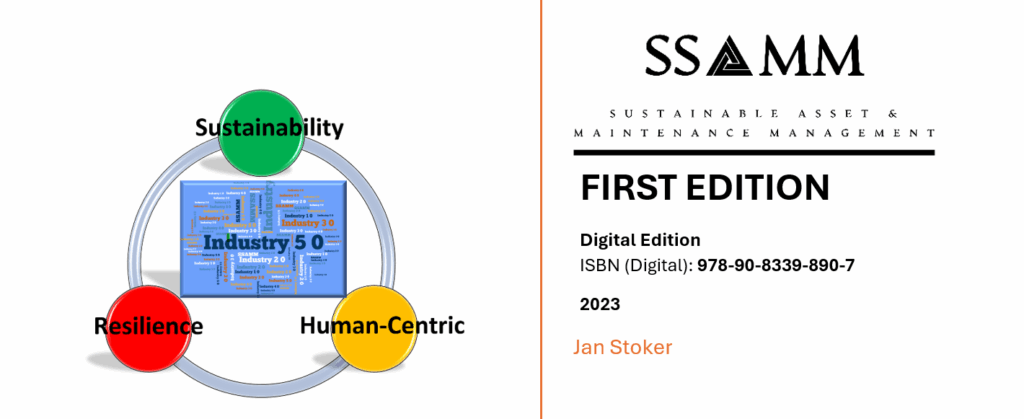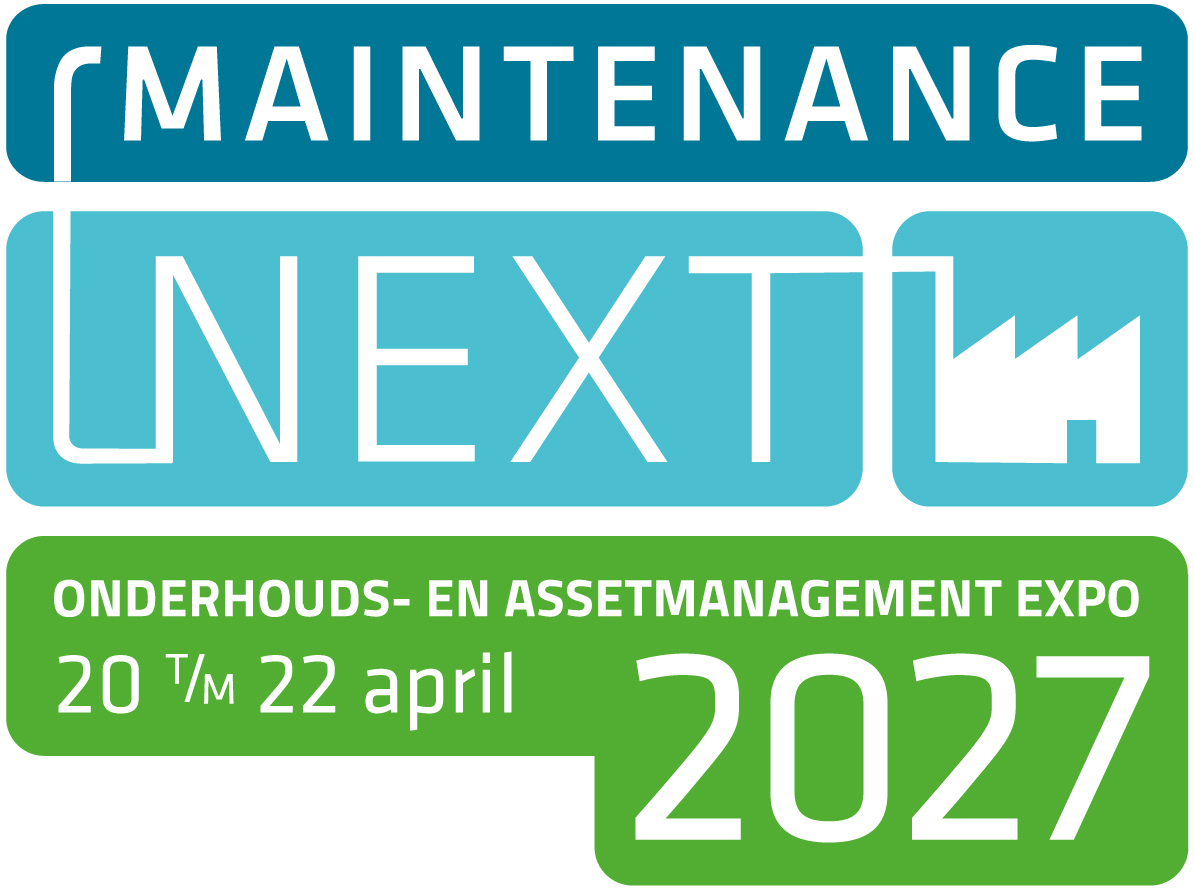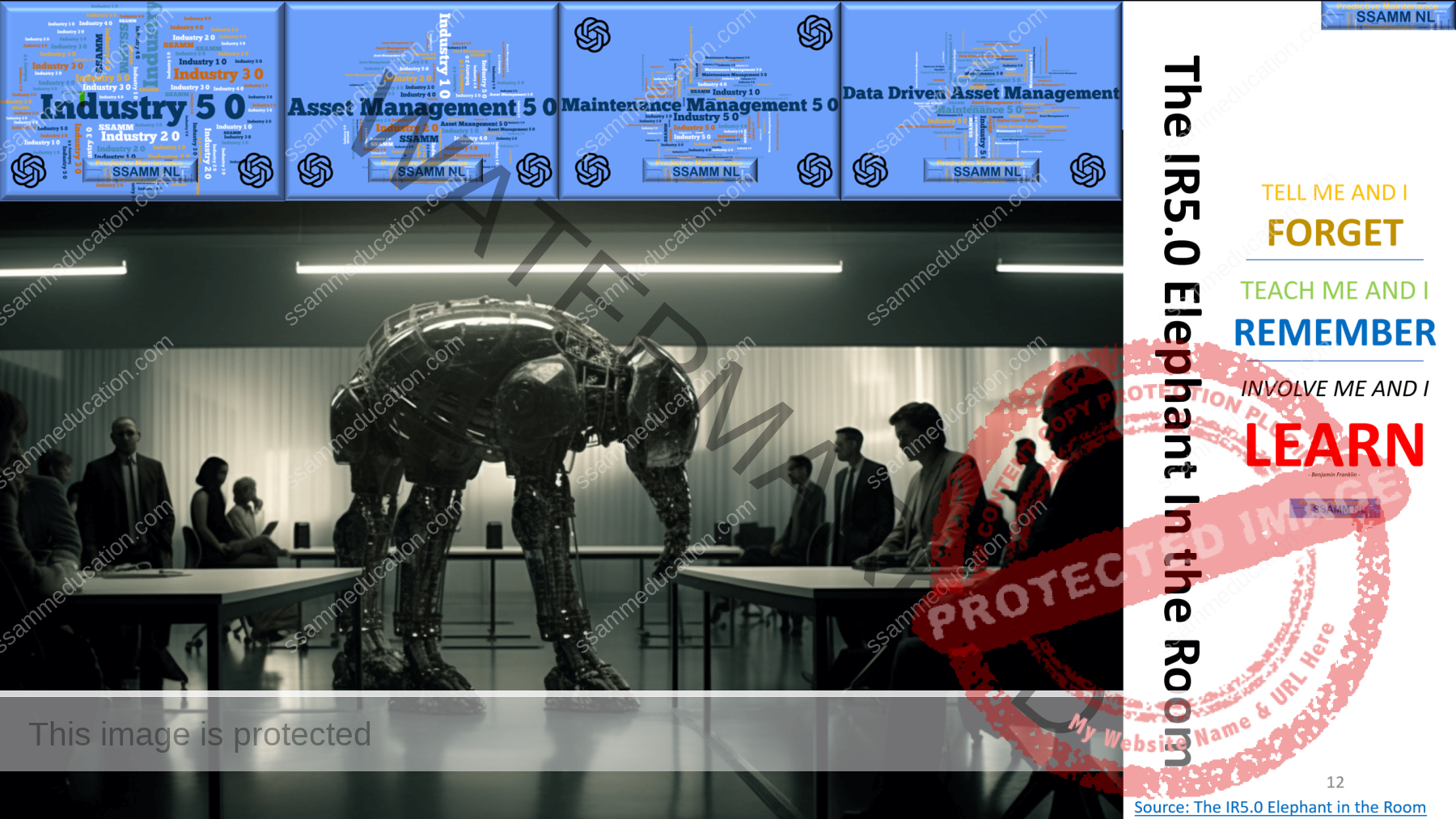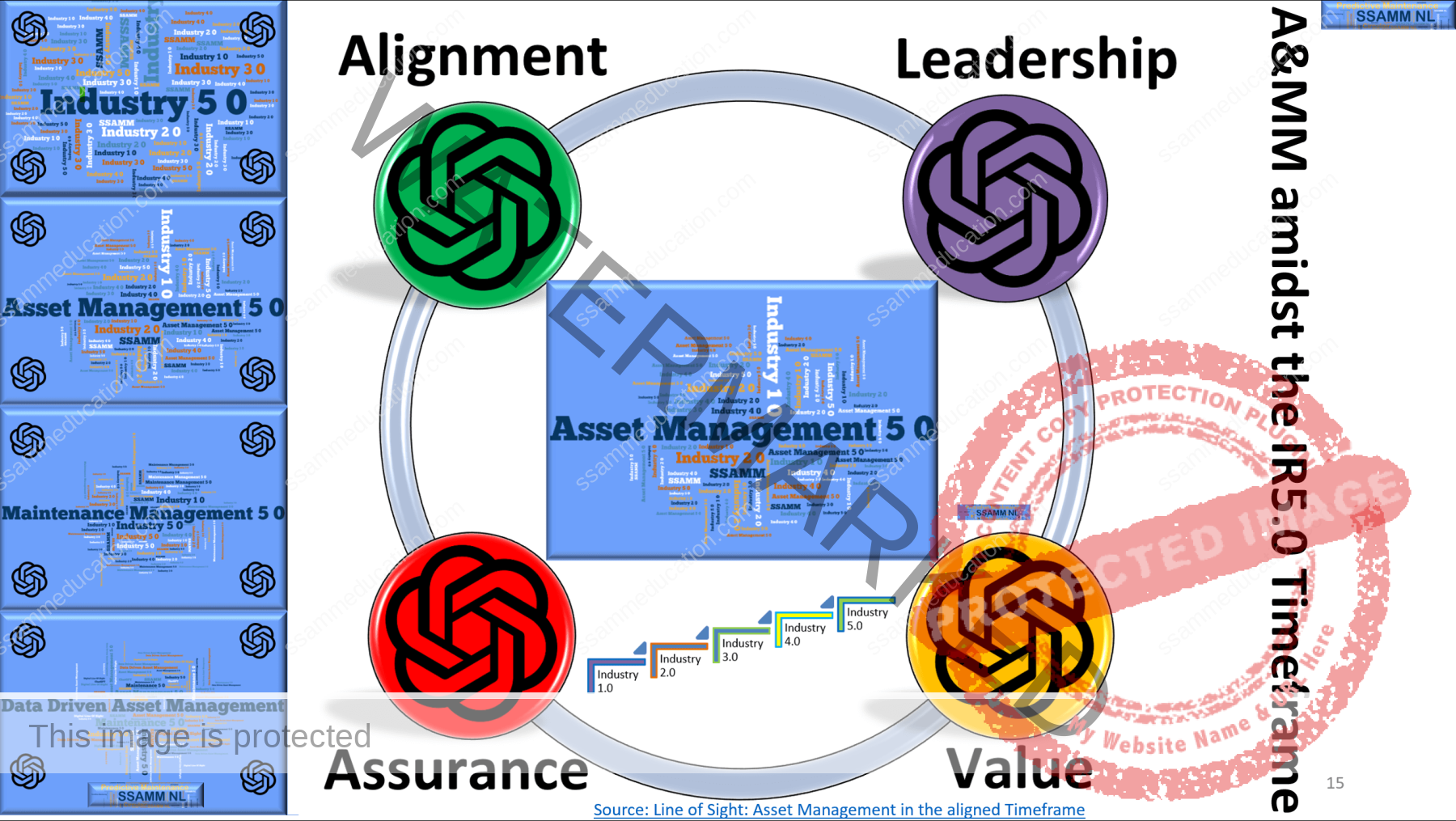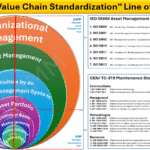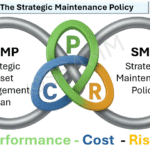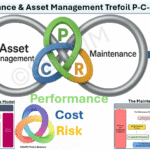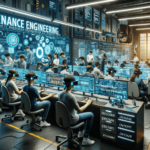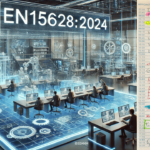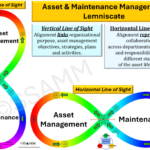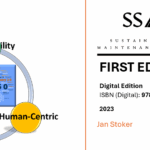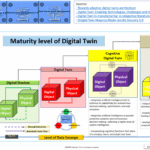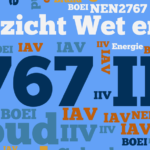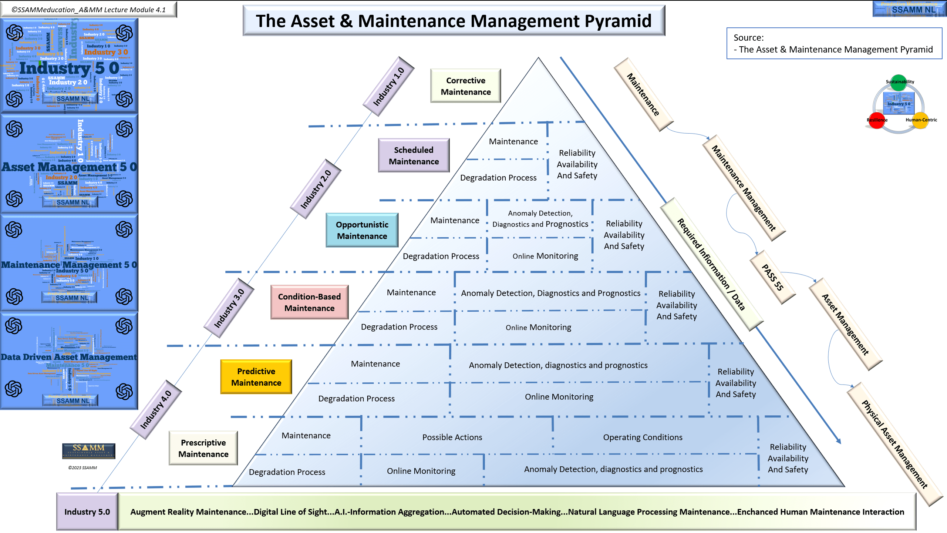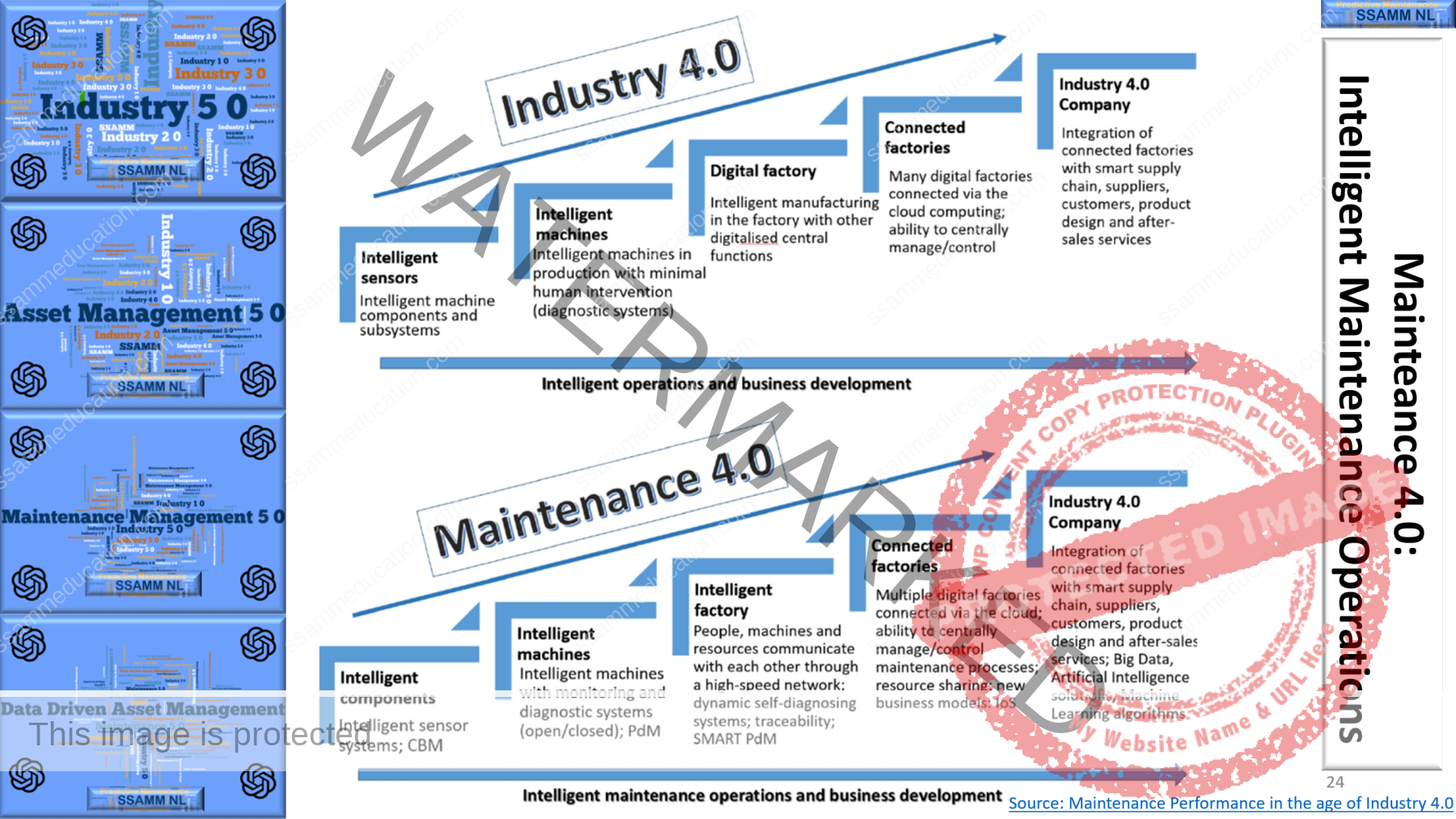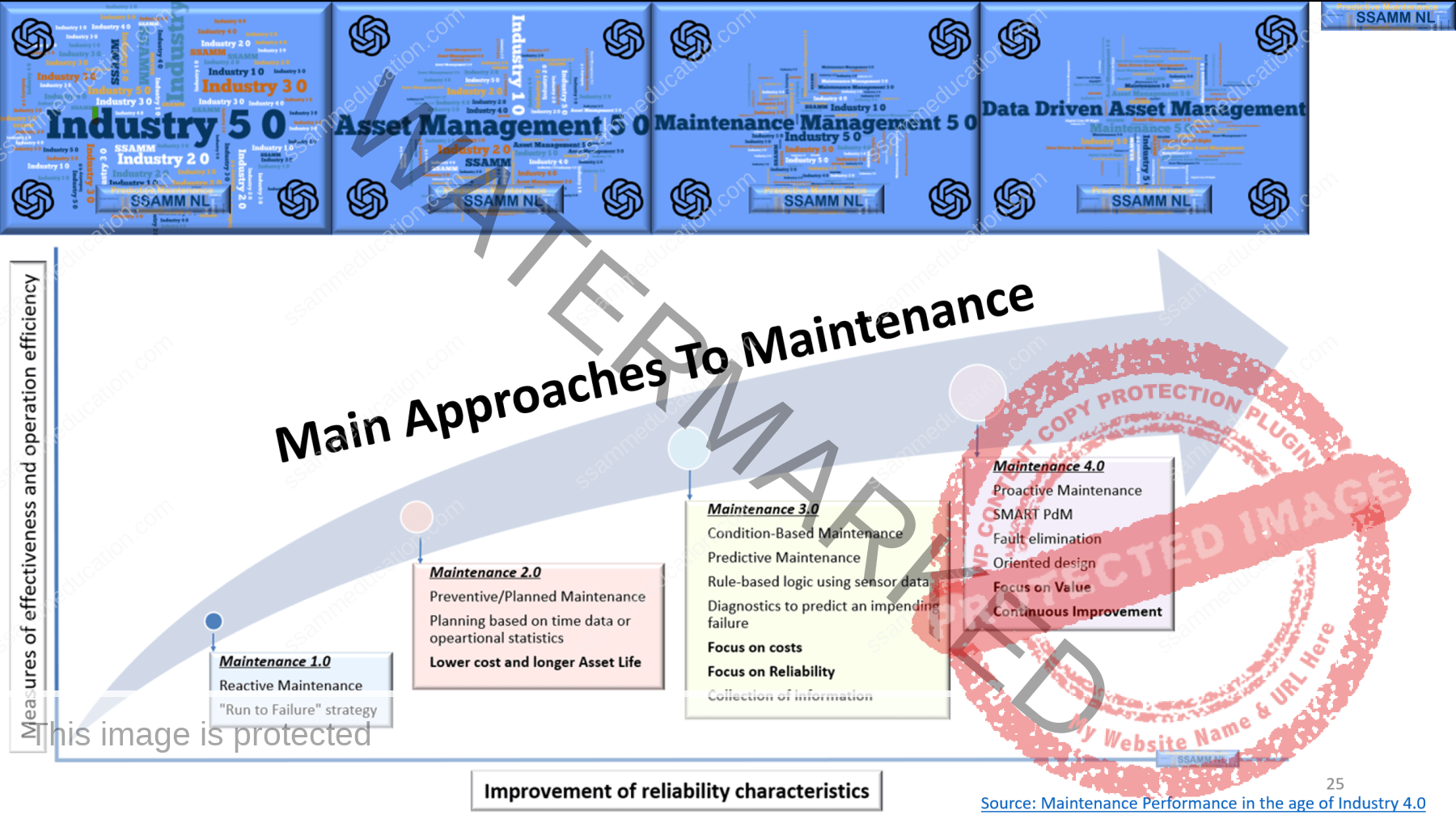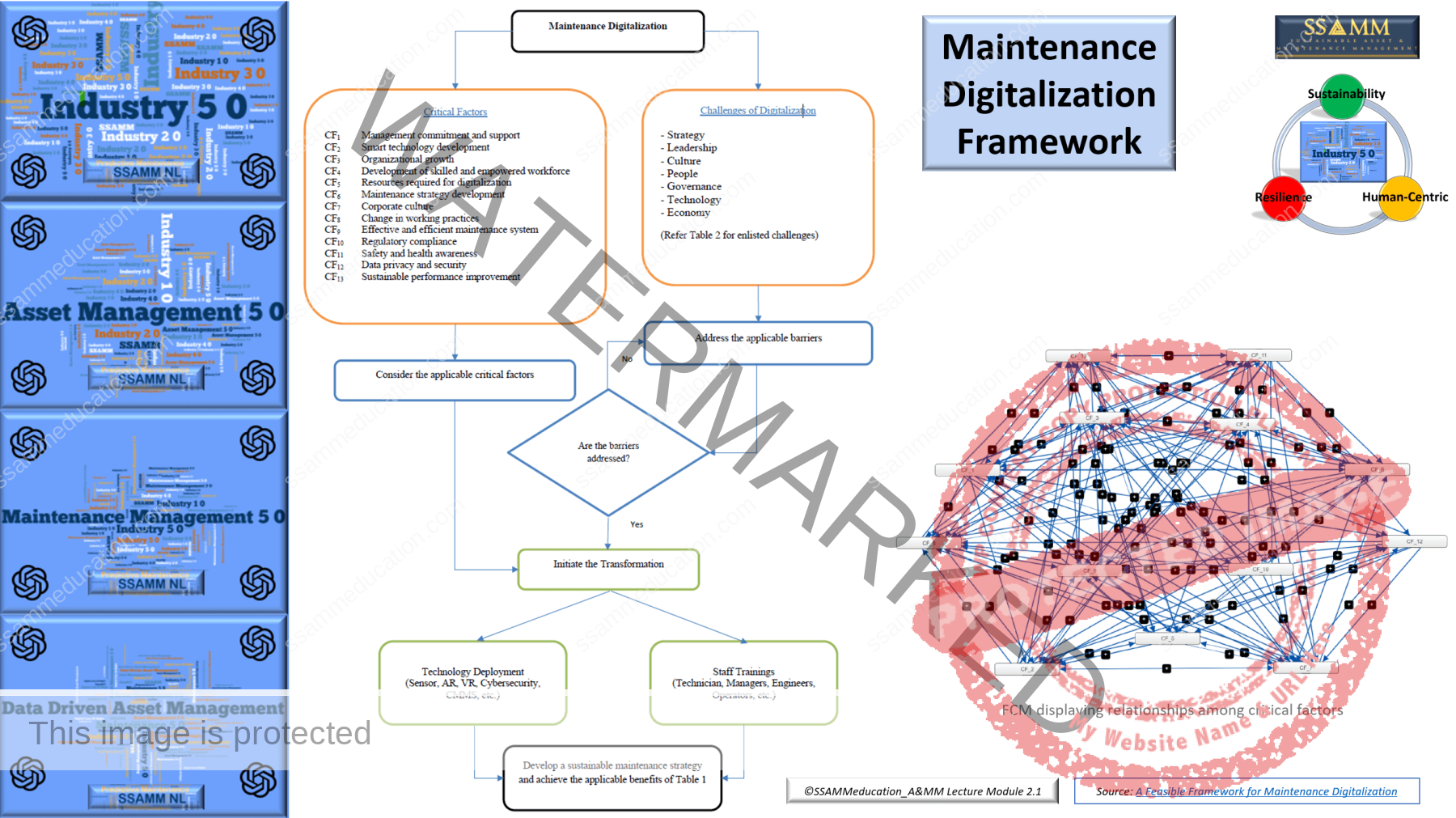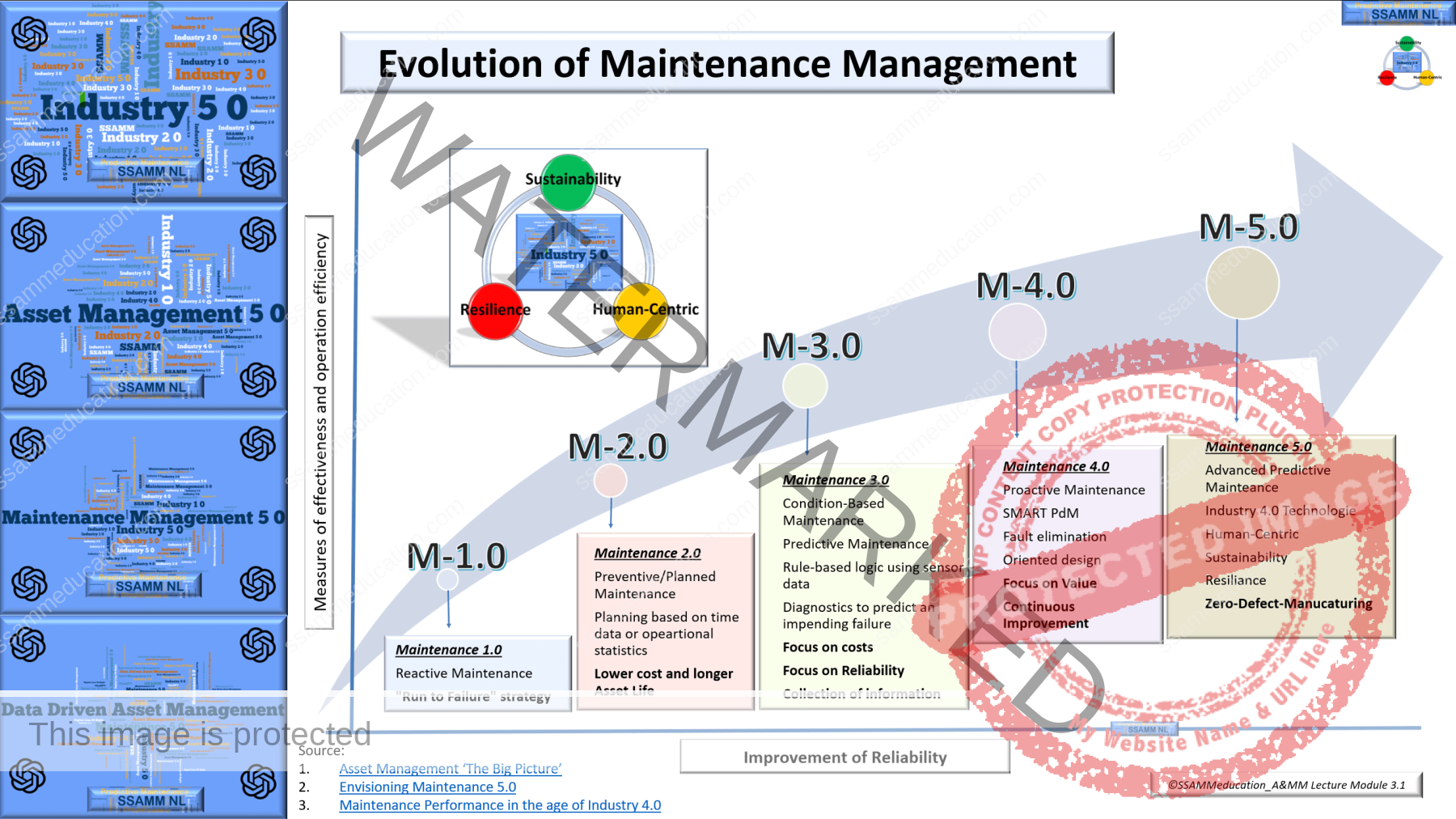In his ‘Learning Journey’ of defining Asset & Maintenance Management, lecturer/Researcher Jan Stoker of SSAMM write his finding and insights during this journey. Started in 2013 with his research, one of his goals is to understand Asset & Maintenance Management within the ISO55000 framework. Currently, his main goal is to describe and define Asset Management 5.0 based on this article. Check the related article’s on this page.
Publication 8 January 2022
Updated 15 June 2023 ME integration
Updated 4 September 2023 IR-5.0 integration
Updated 17 September added Maintenance Management 5.0
- Industry 5.0: Deepening The Subject
- The Asset & Maintenance Management Pyramid
- The Digital Line of Sight: Deepening the subject
- Maintenance Management: Deepening the subject
- Digital Twin: Deepening the subject
- The Asset Management BowTie
- Conference Article
- Article IR5.0 Human-Centric
- The IR5.0 elephant in the room
- Decision-making with AI
- AM 5.0: Balancing Risk, Performance and Value
Countdown SSAMM Academy Module 1
Explore the SSAMM Academy Asset Management and Maintenance Management courses.
Click Here for the Smart information page
Author: Ing. Jan Stoker MSc. MEng. Follow Jan Stoker
In today’s rapidly evolving industrial landscape, the importance of maintenance cannot be overstated. Effective maintenance strategies are the cornerstone of seamless operations, minimizing downtime, optimizing resource allocation, and ensuring safety. Over the years, maintenance approaches have undergone significant transformation, and at the heart of this evolution lies the critical role of data. From the traditional corrective maintenance to the cutting-edge prescriptive maintenance, data has become the driving force, shaping the future of industrial maintenance strategies.
Data is the driving force behind the evolution of maintenance strategies. From traditional corrective maintenance to cutting-edge prescriptive maintenance, data enables organizations to transition from reactive to proactive approaches, reducing downtime, minimizing costs, and optimizing resource allocation. As technology continues to advance, the role of data in maintenance will only become more critical, helping industries achieve higher levels of efficiency, productivity, and sustainability. Embracing data-driven maintenance is not just a choice; it’s a necessity for staying competitive in today’s dynamic industrial landscape.
Click To Enlarge
1. Industry 1.0: The Birth of Mechanization and Corrective Maintenance
Defining Industry 1.0
Industry 1.0, often referred to as the First Industrial Revolution, emerged in the late 18th century. It marked the transition from agrarian and craft-based economies to industrialized societies powered primarily by water and steam engines. This era gave rise to factories and mechanized production.
Corrective Maintenance – A Reactive Approach
In Industry 1.0, asset management and maintenance were in their infancy. The dominant strategy was corrective maintenance, a highly reactive approach. Assets were repaired or serviced only when they failed or showed signs of malfunction. Predictive maintenance was virtually impossible due to the lack of real-time data and monitoring systems. This approach resulted in frequent production disruptions, costly downtime, and inefficient resource allocation.
Data & Corrective Maintenance
Corrective maintenance, often dubbed “break-fix” maintenance, operates in a reactive manner, addressing issues as they occur. While it may seem at odds with the data-driven approach, data still plays a crucial role in post-failure analysis. Data on the frequency, nature, and impact of failures provides invaluable insights. By examining these data points, organizations can optimize their future maintenance strategies, reducing overall downtime and costs.
2. Industry 2.0: Electricity and the Advent of Scheduled Maintenance
Industry 2.0 – The Age of Electricity
The Second Industrial Revolution, Industry 2.0, unfolded in the late 19th and early 20th centuries. It was characterized by the widespread adoption of electricity, which revolutionized production processes and led to significant advancements in various industries.
Scheduled Maintenance – Transitioning Towards Prevention
With the introduction of electricity, there arose a demand for more reliable maintenance strategies. Scheduled maintenance became the norm during Industry 2.0, representing a shift towards preventive measures. Assets were subjected to regular inspections and servicing at predetermined intervals. While this approach was an improvement over corrective maintenance, it still faced challenges in efficiently addressing unplanned downtime.
Data & Scheduled Maintenance
Scheduled maintenance relies on predetermined time intervals or usage thresholds to dictate when assets should be serviced. Data is instrumental in establishing these schedules. Historical data and equipment usage patterns help organizations strike a balance between regular upkeep and minimizing disruptions. The data-driven analysis can further fine-tune these schedules, enhancing their efficiency and cost-effectiveness.
Click to enlarge
Asset & Maintenance Management ‘The Big Picture’ versus Generations.
To get insight in the impact of technology, several perspectives have to be combined and related. This visual represents the Industrial Revolutions from a time perspective and the evolutions of Asset & Maintenance Management.
In this revised version is added Industry 5.0 as the latest development stated by the European Union mid 2020. Even though Industry 5.0 is a relatively new concept, some early academic writing describing the main features of this notion exists. The analysis of the Industry 5.0 literature shows a lot of uncertainty about what it will bring and how it will disrupt business in detail, as well as about its potential to break down barriers between the real world and the virtual one.
Based on the literature review and our forward-looking analysis, Industry 5.0 will be defined by a re-found and widened purposefulness, going beyond producing goods and services for profit. This wider purpose constitutes three core elements:
1- Human-centricity,
2- Sustainability and
3- Resilience.
Also humans evaluate as well with the generations in that same time perspective. The today’s question is if the nowadays generations are capable to keep pace with the incredible speed of the technologies developments like A.I. In the considerations of Jan Stoker the impact of technological developments are way too much to understand and oversee the impact. In his belief’s technology at itself is ‘disruptive’. He explains and points out why the body of thoughts Industry 5.0 in the field of A&MM could be an escape and give direction for the next decades
3. Industry 3.0: Automation, Computing, and Opportunistic Maintenance
Industry 3.0 – The Dawn of Automation and Computing
Industry 3.0, which began in the mid-20th century and continues today, is characterized by automation, computing, and the rapid advancement of digital technology. This era witnessed the integration of computers and electronics into industrial processes.
Opportunistic Maintenance – Leveraging Planned Downtime
Opportunistic maintenance gained prominence during Industry 3.0. With increasing automation, organizations capitalized on planned shutdowns or production pauses to perform maintenance activities. This approach aimed to maximize asset uptime while minimizing production disruptions. However, it still relied on scheduled events rather than real-time asset data.
Data & Opportunistic Maintenance
Opportunistic maintenance leverages planned downtime or production pauses to perform maintenance activities. Identifying these windows of opportunity is where data comes into play. Real-time data monitoring and analysis enable organizations to optimize when and how to execute maintenance activities. This ensures maximum asset availability while minimizing production disruption.
4. Industry 4.0: Smart Manufacturing and Advanced Maintenance Strategies
Industry 4.0 – The Era of Smart Manufacturing
Industry 4.0 represents the fusion of digital technologies, the Internet of Things (IoT), and advanced data analytics into industrial processes. This ongoing revolution is shaping the future of asset management and maintenance.
The Spectrum of Advanced Maintenance Strategies
In Industry 4.0, a spectrum of advanced maintenance strategies has emerged, each building upon the previous ones:
- Condition-Based Maintenance: Real-time data from sensors and monitoring systems enable organizations to continuously assess asset health. Maintenance activities are triggered based on actual asset condition rather than arbitrary schedules.
- Predictive Maintenance: Advanced analytics, machine learning, and AI-driven algorithms predict when assets are likely to fail. This proactive approach allows for precise scheduling of maintenance activities, reducing costs and downtime.
- Prescriptive Maintenance: The pinnacle of maintenance strategy, prescriptive maintenance not only predicts failures but also prescribes the most efficient maintenance actions. It takes into account factors such as cost, safety, environmental impact, and resource utilization, ensuring optimal asset management.
4.1 Data & Condition-Based Maintenance
Condition-based maintenance represents a significant shift towards a proactive approach that relies heavily on real-time data. Sensors and monitoring systems continuously collect data on asset health. When specific conditions deviate from the norm, maintenance is triggered. Data is the driving force here, empowering organizations to respond precisely when assets require attention. This minimizes unnecessary maintenance and its associated costs.
4.2 Data & Predictive Maintenance
Predictive maintenance takes data analysis to the next level by incorporating advanced analytics, machine learning, and AI. The core of this strategy is predicting when an asset is likely to fail. Data from sensors, historical records, and even external sources are critical inputs. Predictive maintenance empowers organizations to plan maintenance activities with pinpoint accuracy, reducing downtime, lowering maintenance costs, and extending asset lifespan.
4.3 Data & Prescriptive Maintenance
Prescriptive maintenance represents the pinnacle of data-driven maintenance strategies. It doesn’t just predict failures; it prescribes the most efficient actions to take. Data is paramount here, as AI algorithms analyze numerous variables, including historical data, to make recommendations that balance cost, safety, environmental impact, and resource utilization. This optimizes asset management and maintenance, ensuring the most efficient path forward.
4.4 The Impact of AI in Predictive and Prescriptive Maintenance
Artificial Intelligence (AI) plays a pivotal role in the evolution of maintenance strategies, especially in predictive and prescriptive maintenance:
- Predictive Maintenance with AI: AI algorithms analyze vast datasets from sensors and historical maintenance records to identify patterns and anomalies. This enables organizations to predict when assets are likely to fail with a high degree of accuracy, allowing for timely maintenance interventions. The result is reduced downtime and lower maintenance costs.
- Prescriptive Maintenance with AI: AI-driven prescriptive maintenance goes beyond prediction. It recommends the most efficient maintenance actions based on a holistic analysis of factors like cost, safety, environmental impact, and resource utilization. AI considers complex variables and optimizes maintenance schedules, ensuring assets are serviced precisely when needed, reducing costs, and maximizing asset lifespan.
5. Industry 5.0: The Human-Centric Approach and the Future of Maintenance
Industry 5.0, the latest paradigm in industrial evolution, represents a profound shift in how we envision the future of manufacturing. This era is marked by a renewed focus on the human element within the industrial landscape, underlining the importance of collaboration between humans and machines. Here, we delve into the core principles of Industry 5.0, emphasizing its human-centric nature, resilience, and sustainability.
5.1 Human-Centric Approach
In Industry 5.0, the spotlight shines on the collaboration between humans and machines. This approach recognizes the unique strengths of each and seeks to leverage them synergistically. It encourages the workforce to actively participate in decision-making, problem-solving, and creativity, thereby enhancing overall productivity and job satisfaction. Human workers are not replaced but rather augmented by technology, leading to a more inclusive and adaptable industrial environment.
5.2 Resilliance in Adversity
Resilience is a defining characteristic of Industry 5.0. By prioritizing human-machine collaboration, this paradigm equips industries with the agility to withstand disruptions and adapt swiftly to changing circumstances. In the face of unexpected challenges, such as the recent global health crisis, the resilience of Industry 5.0 has proven invaluable. By empowering the workforce to be versatile and innovative, industries can maintain productivity and meet evolving demands even in adverse conditions.
5.3 Sustainability as a guiding Principle
Sustainability is at the core of Industry 5.0. This paradigm recognizes the critical need to balance industrial growth with environmental responsibility. By embracing sustainable practices, such as resource optimization and waste reduction, Industry 5.0 promotes eco-friendly manufacturing processes. The collaboration between humans and machines also fosters an environment where energy-efficient and environmentally conscious decisions become integral to daily operations, ensuring long-term ecological viability.
5.4 Industry 5.0- The Human-Machine Collaboration
Industry 5.0, the latest phase in industrial development, emphasizes the integration of humans and machines. It seeks to maximize the strengths of both to achieve more flexible, efficient, and sustainable manufacturing processes.
Click to enlarge. Click here for the supporting article: A Feasible Framework for Maintenance Digitalization
Click to enlarge. Click here for the supporting article: A Feasible Framework for Maintenance Digitalization
6. The Future of Maintenance in Industry 5.0
As we evolve into the era of Industry 5.0, maintenance management sees transformative shifts. From traditional reactive methods to the predictive algorithms of Industry 4.0, we now face Maintenance Management 5.0 that focuses on resilience, sustainability, and a human-centric approach. This article delves into these principles, elucidates the difference between Maintenance Management 4.0 and 5.0, and underscores the pivotal role of maintenance management in the new industrial landscape.
In Industry 5.0, the evolution of maintenance strategies continues, but with a deeper focus on human-machine collaboration:
- Enhancing Human Expertise: Industry 5.0 leverages the skills and knowledge of human workers, who work in collaboration with advanced technologies to make maintenance decisions that consider a broader range of factors.
- Human-Machine Collaboration: Collaborative robotics, augmented reality, and advanced training techniques allow human workers to interact seamlessly with machines, enhancing their maintenance capabilities. This collaborative approach optimizes asset management by combining the precision of AI with the adaptability of human intelligence.
- Sustainable Practices: Industry 5.0 places a strong emphasis on sustainable maintenance practices that minimize environmental impact and maximize resource efficiency. AI-driven analytics help identify opportunities for reducing waste and energy consumption, contributing to a more sustainable future.
Industry 4.0 paved the way for intelligent, connected systems, where the Internet of Things (IoT) and big data analytics played significant roles in optimizing manufacturing and maintenance processes. As Industry 5.0 emerges, we transition from mere digitization to a model that values the convergence of human intelligence with machine capabilities, emphasizing resilience, sustainability, and a human-centric approach.
6.1 Maintenance management 4.0
Maintenance Management 4.0 was characterized by the following:
- Predictive Maintenance: Utilizing sensors and analytics to predict when equipment would fail.
- Connectivity: Assets connected through IoT, allowing for remote monitoring and diagnosis.
- Big Data: Leveraging vast amounts of data for insights into performance and potential optimizations.
- Automated Workflows: Routine maintenance tasks became automated, decreasing downtime.
6.2 Maintenance Management 5.0
Maintenance Management 5.0 builds upon the foundations of its predecessor, integrating:
- Human-Machine Synergy: Rather than merely automating, there’s a collaboration between human intuition and machine precision.
- Adaptive Maintenance: Beyond predictive, systems learn and adapt based on evolving conditions and unforeseen challenges.
- Sustainable Practices: Maintenance activities consider environmental impacts, promoting practices that are eco-friendly.
- Resilient Infrastructure: Maintenance that prepares systems to withstand disruptions, ensuring continuity in adverse situations.
- Holistic Well-being: Maintenance practices that also consider the well-being and health of operators and other stakeholders.
6.3 Impact of Maintenance Management in the Industry 5.0 topics
Resilience
In the age of Industry 5.0, resilience is not merely about the durability of equipment but also about creating systems that can bounce back from disruptions, whether they be cyber-attacks, natural disasters, or other unexpected events. Maintenance Management 5.0 involves strategies to ensure that assets can quickly recover, emphasizing modularity, redundancy, and rapid response capabilities.
Sustainability
Sustainability transcends the buzzword status in Industry 5.0. Maintenance practices now incorporate eco-friendly methods, waste reduction, and energy-efficient operations. This is a recognition that long-term operational success requires harmony with the environment, reducing the carbon footprint, and ensuring that resources are utilized optimally.
Human-Centric
While Industry 4.0 was criticized for potentially reducing human roles in operations, Industry 5.0 emphasizes the irreplaceable value of human intuition, creativity, and expertise. Maintenance Management 5.0 promotes practices that consider the safety, well-being, and ergonomic needs of operators. Machines assist humans rather than replace them, making tasks safer, more efficient, and more intuitive.
7. Wrap up
The evolution of asset management and maintenance strategies across the industrial revolutions is a testament to humanity’s relentless pursuit of efficiency, reliability, and cost-effectiveness in industrial operations.
From the reactive practices of Industry 1.0 to the advanced prescriptive maintenance of Industry 4.0 and the human-centric approach of Industry 5.0, each phase has brought significant improvements.
As organizations continue to embrace the latest technologies, including AI, and adhere to established standards, they are better equipped to adapt to the ever-changing industrial landscape.
The journey continues, with Industry 5.0 promising an era of unprecedented collaboration between humans and machines in asset management and maintenance, ushering in a new era of efficiency, sustainability, and productivity.
Back to post: Click Here or follow Sustainable Asset Management
8. Reference Articles
8.1 Industry 5.0 Related
- Maturity assessment for Industry 5.0: A review of existing maturity models
- Industry 5.0: Past, Present and Near Future
- IR5.0 Human-Centric underpinned with 2022 Industrial Maintenance study
- Human in the loop: Industry 4.0 vs. Industry 5.0: Co-existence, Transition, or a Hybrid
- Industry 5.0 further explained
- Industry 5.0 and Society 5.0: Comparison, complementation and co-evolution
- Outlook on human-centric manufacturing towards Industry 5.0
- Maintenance 5.0: Towards a Worker-in-the-Loop Framework for Resilient Smart Manufacturing
- Industry 5.0: Prospect and retrospect
- Industry 5.0 definitions
- Be informed…. we are already in the Industry 5.0 timeframe
8.2 IR4.0 & IR4.0 Readiness
- An Industry 4.0 readiness Assessment tool
- Intelligent warehouse in Industry 4.0
- Maintenance Performance in the Age of Industry 4.0
- Simulating dynamic RUL based CBM scheduling
- Maintenance Analytics – The New Know in Maintenance
- Rethinking Maintenance Terminology for an Industry 4.0 Future
- Maintenance optimization in industry 4.0; Strategies, Information and the Reversed Data Pyramid
- An RUL-informed approach for Life Extension of high-value assets: Overview of LE practice
- Lean Maintenance 4.0: implementation for aviation industry
- Developing prescriptive maintenance strategies in the aviation industry
- Development of flexible Predictive Maintenance systems in the context of industry 4.0: the implementation framework
8.3 Digital Twin Related
- Reflection: Disruptive Innovation Asset & Maintenance Management
- Collecting Real-Time Data for Predictive Maintenance
- Lean Maintenance 4.0: implementation for aviation industry
- A digital twin-based decision analysis framework for operation and maintenance of tunnels
- Digital building twins and blockchain for performance-based (smart) contracts
- IoT for predictive assets monitoring and maintenance: An implementation strategy
- About auditing in the field of Asset Management
- A Digital Twin Design for Maintenance Optimization
- The difference between Machine Learning(ML) and Deep Learning (DP)
- Digital Twin Definitions: a time perspective
- Definition Digital Twin
- Approach for a Holistic Predictive Maintenance Strategy by Incorporating a Digital Twin
- Data-driven failure mode and effect analysis (FMEA) to enhance maintenance planning
- Advances of Digital Twins for Predictive Maintenance
- The 250 classifications of Digital Twin technology
8.4 Maintenance Management
- Decision-based framework for Predictive Maintenance Technique selection in Industry 4.0
- Data-driven failure mode and effect analysis (FMEA) to enhance maintenance planning
- Recent advances and trends of predictive maintenance from data driven machine prognostics perspective
- Data-driven decision-making for equipment maintenance: Data-driven RCM
- Toward cognitive predictive maintenance: A survey of graph-based approaches
- A deep learning predictive model for selective maintenance optimization
- Inspection schedule for prognostics with uncertainty management
- Development of Digital Twin for Intelligent Maintenance of Civil Infrastructure
- Risk Based Inspection Framework part of evolutions in Maintenance Management; Framework and Process
- KSPMI: A Knowledge-based System for Predictive Maintenance in Industry 4.0
- Sharping the mind: Find The Sweet spot
- The Bathtub Curve Fallacy
- The framework for data-driven maintenance planning and problem-solving in maintenance communities
- The Maintenance Body of Knowledge
- Decision Framework for Predictive Maintenance Method Selection
- Maintenance Engineering defined
- The Maintenance 5.0 Framework
- The Maintenance 5.0 Cycle
8.5 Interpretation Article’s
- Line of Sight: Asset Management in the aligned timeframe
- Interpretation Figure 1 ISO55000
- The elephant in the room
- Asset & Maintenance Management amidst the Industry 5.0 timeframe
- Revised A&MM The Big Picture
- Article IR5.0 Human-Centric
- Explaining Predictive Maintenance using the KISS-Principle
- Asset Management 5.0: Balancing Risk, Performance and Value with IR5.0
- Food for Thoughts: ChatGPT in the field of Asset & Maintenance Management.
8.6 Additional Pages To Consult
- Sustainable Asset Management
- The Maintenance Engineer
- The Maintenance Manager
- The Asset Manager
- Industry 5.0
- Circular Asset Management


